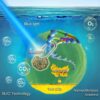In humans, virtually every cell stores fat. However, patients with a rare condition called congenital lipodystrophy, which is often diagnosed in childhood, cannot properly store fat, which accumulates in the body’s organs and increases the risk of early death from heart or liver disease. In 2001, a transmembrane protein called seipin was identified as a molecule essential for proper fat storage, although its mechanism has remained unknown.
An international study published in Nature Structural & Molecular Biology is the first to solve and model virtually the entire structure of seipin, revealing it exists in two conformations and pointing to the mechanism for birthing the lipid droplets used for fat storage in healthy cells.
“Lipid droplets (LDs) have been described since the invention of microscopes that could show the inside of cells. For about a century, they’ve been known to store lipids, or fats, but they were considered inactive. During the past 20 years, lipid droplets have been shown to be very dynamic,” said Joel M. Goodman, Ph.D., Professor of Pharmacology at UT Southwestern, a Distinguished Teaching Professor, and one of the study’s three corresponding authors.
Dr. Goodman has played a key role in seipin biology, discovering in 2007 that seipin is responsible for packaging fat into LDs and that the same mechanism occurs in animals, plants, and fungi. In 2010, the Goodman lab was the first to purify seipin and reported that it was composed of about nine identical subunits that resembled a donut.
Ever since, scientists around the world had tried to solve the structure, which proved very difficult because seipin stretches across the membrane of the endoplasmic reticulum, an organelle within the cell. That transmembrane placement made the complex resistant to X-ray crystallography, the longtime gold standard for such studies. Membrane proteins are notoriously difficult to crystallize, a requirement for that technique.
To tackle the problem, Dr. Goodman turned to cryogenic electron microscopy (cryo-EM) after discussions with Boston cell biologist Tobias C. Walther, Ph.D., at a scientific conference. Dr. Walther, a Howard Hughes Medical Institute Investigator, and his colleague, Robert V. Farese Jr., M.D., are the study’s other corresponding authors. They both have appointments at Harvard Medical School, the T.H. Chan School of Public Health, and the Broad Institute of MIT and Harvard. The study used the Harvard cryo-EM facility.
Cryo-EM uses flash-frozen samples, electron beams, and an electron detector rather than a camera to gather data on biological structures at near-atomic scale. Using cryo-EM enabled the researchers to determine that the “donut” they hypothesized was actually a 10-unit cage, a sort of incubator to create and grow lipid droplets. The second conformation showed seipin opening to release the lipid droplet onto the surface of the endoplasmic reticulum. Once on the surface, the LDs face the cell’s soupy interior (the cytoplasm), where passing enzymes can break down the LDs and free the fatty acids inside to provide energy such as during times of starvation, Dr. Goodman said.
“Getting two conformations was amazing, totally unexpected,” Dr. Goodman said, adding that previously other research teams had gotten a partial solution showing the lower layer of the seipin complex contained within the tube-like endoplasmic reticulum. The two conformations in the current investigation solve the elusive upper part of the structure, which extends across the organelle’s membrane.
“Cryo-EM made it possible,” Dr. Goodman said. “We hope that this structure will lead to a way of connecting seipin’s role in lipid-droplet creation to whatever goes wrong in lipodystrophy as well as help us better understand lipid-droplet formation in general,” he added. “There are likely several other proteins involved in the creation of lipid droplets, but seipin appears to be the main one. It seems to be a machine that generates lipid droplets.”
More information:
Henning Arlt et al, Seipin forms a flexible cage at lipid droplet formation sites, Nature Structural & Molecular Biology (2022). DOI: 10.1038/s41594-021-00718-y
Provided by
UT Southwestern Medical Center
Citation:
Solving a decades-old structural mystery surrounding the birth of energy-storing lipid droplets (2022, February 25)


